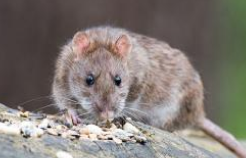Norway Rats
Learn More About Norway Rats
Norway rats live in close association with people. They live in and around residences, in cellars, warehouses, stores, slaughterhouses, docks, and in sewers. On farms, they may inhabit barns, granaries, livestock buildings, silos, and kennels. Norway rats will eat nearly any type of food. Norway rats are primarily nocturnal. They usually become active about dusk, when they begin to seek food and water. They can cause structural damage to buildings by burrowing and gnawing, transmit diseases, and contaminate food. If you find Norway rats in your home, we can help!
| Pest Identification: | |
|---|---|
| Size | 6-8 in. and weigh approximately 1 lb. |
| Color | Gray to brown |
| Body Structure | Heavy, thick body with shaggy hair, small eyes and a blunt nose. Typically, the tail is shorter than the length of the head and body. |
| Characteristics | Norway rats reach maturity within 2 months of birth and breed year-round. Females may have as many as seven litters in a single year with 4-8 offspring per litter. |
| Habitat & Behavior | The Norway rat requires water to survive and will nest in colonies within close proximity to water. That said, the Norway rat is adaptive to living in urban and populated areas and often can be found nesting in crawlspaces, basements, attics and in wall voids inside homes. Often, they will line their nests with shreds of paper or cloth. They are omnivorous and will readily feast on carcasses of dead animals. Likewise, they frequently are carriers of disease and parasites. |
| Prevention & Treatment | Sealing gaps around pipes and caulking cracks around your homes are a good preventative measure. Although traps may be immediately effective, the presence of droppings or other telltale signs, such as holes and bite marks on food items and hard surfaces, may indicate a larger infestation. Because nests are difficult to locate and Norway rats are known carriers of disease and parasites, it is strongly suggested that you contact a pest control professional before administering a do-it-yourself treatment. Find out more about rodent treatment options. |

 (425) 318-7912
(425) 318-7912
 MY ACCOUNT
MY ACCOUNT
 425-318-7912
425-318-7912







